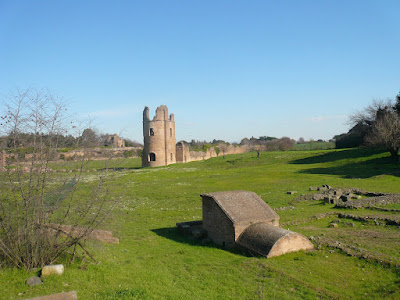
After the visit to the chruch of Santa Croce, three friends and I decided to walk from Rome back to campus along the Via Appia Antica, more commonly known as the Old Appian Way. I do not know how long the section of the road was that we walked, but it takes 30 minutes to cover the same distance by bus on the parallel Appia Nuova. We started out on a radiant Saturday afternoon, and two things became apparent after several hours of brisk walking. 1) The shoes I was wearing had inadequate arch support and 2) I had made the mistake of attempting this feat with three guys as my walking companions, two of whom stand over six feet tall and have considerably longer legs than I do. Take a break? Of course, if you have to. Walk slowly? Of course, if you need to. Needless to say, we didn't do much of either. ;)
The Appian Way itself was beautiful enough to make up for this, however. As it leaves the city proper of Rome the road is paved, alternately with the wide, famous stones of the ancient Romans and more recent cobblestones. Villas give way to fields as the walk progressed, and soon we were passing weathered Roman watchtowers and grassy tombs. In this photograph one can see the ancient paving and wheel marks as well as get a sense of how STRAIGHT the road is.
We shared the Appian Way with bicyclists and joggers for several miles until we passed far away from civilization, and then we had the sun-dappled stones all to ourselves. After sneaking through a closed reconstruction zone, we emerged back onto the familiar road until it was bisected by a busy thoroughfare and afterwards shrank to a simple goat track through lush grass and berry brambles (with the indestructible ancient paving stones peering periodically through moss and wild phlox). The wide road eventually re-appeared just before the road ended at an outdoor market. The walk had taken approximately 4.5 hours, and we arrived home just before sunset.





 After the visit to the chruch of Santa Croce, three friends and I decided to walk from Rome back to campus along the Via Appia Antica, more commonly known as the Old Appian Way. I do not know how long the section of the road was that we walked, but it takes 30 minutes to cover the same distance by bus on the parallel Appia Nuova. We started out on a radiant Saturday afternoon, and two things became apparent after several hours of brisk walking. 1) The shoes I was wearing had inadequate arch support and 2) I had made the mistake of attempting this feat with three guys as my walking companions, two of whom stand over six feet tall and have considerably longer legs than I do. Take a break? Of course, if you have to. Walk slowly? Of course, if you need to. Needless to say, we didn't do much of either. ;)
After the visit to the chruch of Santa Croce, three friends and I decided to walk from Rome back to campus along the Via Appia Antica, more commonly known as the Old Appian Way. I do not know how long the section of the road was that we walked, but it takes 30 minutes to cover the same distance by bus on the parallel Appia Nuova. We started out on a radiant Saturday afternoon, and two things became apparent after several hours of brisk walking. 1) The shoes I was wearing had inadequate arch support and 2) I had made the mistake of attempting this feat with three guys as my walking companions, two of whom stand over six feet tall and have considerably longer legs than I do. Take a break? Of course, if you have to. Walk slowly? Of course, if you need to. Needless to say, we didn't do much of either. ;)



